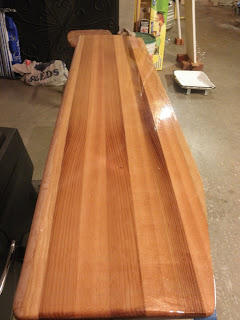After many trips to the hardware store getting stainless steel carriage bolts and machine screws that were often the wrong size, I finally got my rudder box together in some sort of usable fashion. As my intrepid readers may remember in three other previous posts (search in the month of March), I have been trying to figure something out in order to get my tiller to be detachable. I went with the final option, illustrated in this post.
The rudder box is glued up but not glued together.
As you can see, I am wearing my camo Converse sneakers. Very cool. The original tiller design calls for the tiller to be permanently attached to the top of the box, where my shortened tiller stock is now-- so originally that would be much longer, but permanent. This way, I can remove the tiller and leave the rudder in the water, freeing up open space in the boat during quiet times. I used a carriage bolt with a butterfly nut tensioned by a split washer. Don't drop it, and carry a spare!
The spacer is as of now temporary, but I could do one of three things. I could lengthen the spacer to make it full-tiller length, giving the tiller laminate strength; I could shorten the spacer; I could make two evenly spaced spacers, I could leave it the way it is. This is yet to be determined. Here's a closeup for the interested:
I'm having some serious problems with my hardware for the rudder, unfortunately. I wanted a pintle and gudgeon style assembly, but my 1.5" gudgeons are not fitting around my rudder box, even though it's 1.5" wide. Something ain't right. Also, I'd have to expand my tiller access hole in the transom to accommodate the up and down motion to get the rudder in and and out. So I'm scraping the pintle/gudgeon idea and I'm going to go with the gudgeon/gudgeon idea, as the original plans stipulate. Which means I have to find some sort of long pin to thread between all of them. Boo to that.
Also today I've been working on my blades. My rudder got sanded down to the matte finish, and I carefully taped off vertical areas that would run, and applied one last thin coat of epoxy onto one side of the rudder. Tomorrow, the other side. I used a plastic spreader, and it went very well, very smooth, and I'm very happy with my luscious result:
You'll notice on the left hand side that the leading edge still isn't coated, this was taped off earlier.
Then, off to glassing my daggerboard! Much like the same for the rudder, except I cut a bigger piece. I had a lot of runs in my rudder, and I figured this time I would lay the board flat, spread epoxy with a squeegee, and then turn it over, do the other side, and then hang it up.
So I went ahead and did one side horizontally:
I thought I was being pretty smart.
So then I turned it over and did the other side. Something caught my attention and I looked underneath my board and...
... well I didn't take any pictures because needless to say the whole first side has very neatly peeled away from the board, thanks to Mr. Theory-of-Gravity. Gravity is only a theory by the way, they should teach both sides in schools so kids know this, because there is lots of evidence that gravity does not exist, but "they" don't want to show you it. I digress. Today, gravity was obviously working quite well. I finished the job at hand, and then hung it up, and re-spread the cloth down. Fortunately not much damage done, but for my smartness, well, not so smart now. Here it is all hung up to dry:
It's late, I'm still periodically coating the board to get the weave filled, and I'm tired. I timed this one bad.
Thanks for reading!






No comments:
Post a Comment